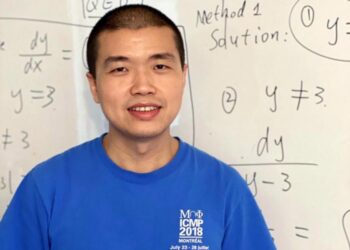NEWPORT NEWS – The U.S. Department of Energy’s Thomas Jefferson National Accelerator Facility is moving forward on a project to gain new insight into the interactions of electrons. The MOLLER experiment will make an extremely precise measurement of the electron’s force field to learn about specific and rare interactions with other subatomic particles. On May 28, the experiment received approvals of both Critical Decision 2 and Critical Decision 3 from the DOE.
NEWPORT NEWS – The U.S. Department of Energy’s Thomas Jefferson National Accelerator Facility is moving forward on a project to gain new insight into the interactions of electrons. The MOLLER experiment will make an extremely precise measurement of the electron’s force field to learn about specific and rare interactions with other subatomic particles. On May 28, the experiment received approvals of both Critical Decision 2 and Critical Decision 3 from the DOE.
The MOLLER research program was established at Jefferson Lab as a DOE Major Item of Equipment (MIE) project to build the equipment required to support the experiment.
These critical decision determinations enable the project to move ahead with procurements, as well as building and installing the apparatus.
“Everyone has very high confidence that we are now in the right position to move forward,” said Ruben Fair, Jefferson Lab’s MOLLER project manager. “There’s a lot of pressure now to deliver and perform. We always knew this was coming, of course, and now it’s here, and the team is ready to move forward.”
Nuclear physicists and engineers have worked to make the scientific case, develop a design for and put in place a robust plan to carry out the experiment at Jefferson Lab. Critical Decision 2, “Approve Performance Baseline,” formally establishes the scope, schedule and budget. Critical Decision 3, “Approve Start of Construction,” is the go-ahead for assembly and installation.
“This is the culmination of an extraordinary team effort in order to convert the technically challenging experimental concept into a complete engineering design, and now to obtain full approval to acquire and construct all the components of the apparatus in a timely manner,” said Krishna Kumar, professor of physics at the University of Massachusetts Amherst and the principal spokesperson for MOLLER. “Congratulations to the entire project team for achieving this critical milestone. In addition, thanks to the principal investigators, postdocs and students from the university groups in the MOLLER collaboration who were always ready to provide any needed input during the design and early acquisition phase.”
The Measurement of a Lepton-Lepton Electroweak Reaction Experiment, or MOLLER experiment, will probe the electrons inside matter to make a precise measurement of the electron’s weak charge. The weak force is one of the four forces in nature, along with the electromagnetic, the strong force and gravity. The electron’s weak charge is a gauge of how much influence the weak force exerts on the electron.
A precision measurement of this quantity provides a stringent test of the Standard Model, the theory that describes the particles and interactions that make up everyday matter.
“It is very exciting and very useful and very much needed because of the precision that it will achieve,” said Klaus Dehmelt, a Jefferson Lab staff scientist and MOLLER deputy project manager.
The experiment will be carried out in Jefferson Lab’s Continuous Electron Beam Accelerator Facility, a DOE Office of Science user facility. In the experiment, a beam of electrons accelerated by CEBAF will interact with electrons from atoms inside a liquid hydrogen target. After the interactions, electrons that come flying out will enter the MOLLER spectrometer.
“The MOLLER spectrometer is very pretty to look at, but it is complex. The tolerances we’re talking about to make sure all these pieces come together to produce one fully functioning bit of equipment are quite phenomenal,” Fair said.
MOLLER’s magnets will separate the electron-electron scattering signal events from the debris of other, unwanted ones. The signal events will then be collected in MOLLER’s state-of-the-art detector systems for measurement.
With these critical approvals now in place, the MOLLER project can move forward with all procurements and building the new spectrometer magnet and detector systems. The goal is to begin installation of MOLLER components in Jefferson Lab’s Experimental Hall A next year.
“It’s fantastic how people are starting to think about the measurement like this and then building everything around the spectrometer, for example, as a piece of superb equipment,” said Dehmelt. “I’m excited for next year in June, when we can really go into the hall and build up the whole device and then see it building, see it growing and becoming reality. That’s the most exciting part for me.”
Further Reading
Critical Decision-3A Clears Way toward Standard Model Test
Partnership Contributes Toward Sharp Eyes for MOLLER Experiment
Experiment to Precisely Measure Electrons Moves Forward
Particle Physicist Takes the Lead on Groundbreaking Electron Measurement
Contact: Jefferson Lab Communications Office, jlabinfo@jlab.org
-end-
Jefferson Science Associates, LLC, a joint venture of the Southeastern Universities Research Association, Inc. and PAE, manages and operates the Thomas Jefferson National Accelerator Facility, or Jefferson Lab, for the U.S. Department of Energy’s Office of Science.
DOE’s Office of Science is the single largest supporter of basic research in the physical sciences in the United States and is working to address some of the most pressing challenges of our time. For more information, visit https://energy.gov/science.
Discover more from Science
Subscribe to get the latest posts sent to your email.



